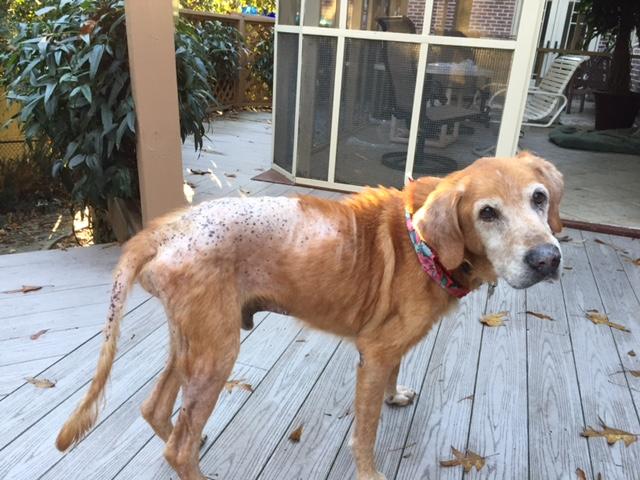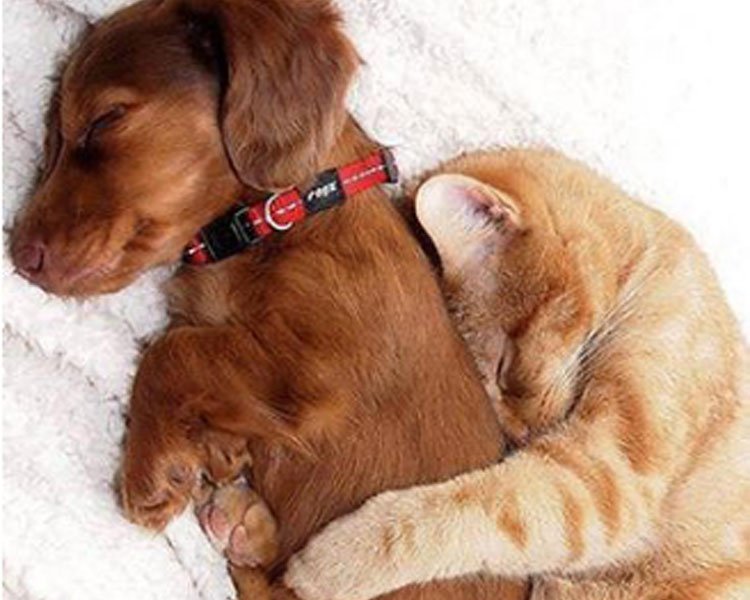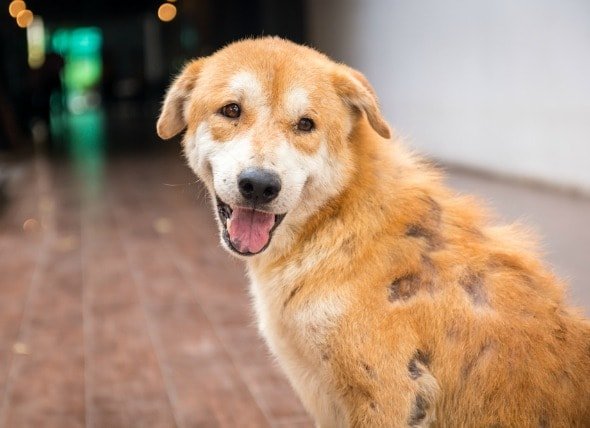What Is Canine Alopecia
Canine alopecia is a medical condition in which there is excessive hair loss in dogs, and which is unrelated to the normal hair shedding and growing cycle as mentioned above.
Alopecia in dogs can be partial and localized , or it can be complete and generalized.
So what causes hair loss in dogs? Read on to find out!
What To Do If You See The Signs Of Your Dog Losing Hair
The good news is that many of the above causes of hair loss can be treated with the help of your vet. Treatments, of course, will vary depending on the root cause of hair loss. Common treatments include:
- Allergy testing and any applicable allergy treatments
- Oral or topical antibiotics to treat bacterial infections
- Antifungals to treat yeast infections or ringworm
- Cleaning wounds and keeping them dry
In addition to treating the underlying conditions that plague your pup, you can pamper her skin and coat. To promote healthy skin and coat, consider:
- Regular grooming
- Staying up-to-date with flea and tick medication
- Supporting your dog from the inside out with a high-quality dog food
- Adding skin-healthy nutrients to your dogs diet
- Using shampoos specifically formulated for dogs
- Incorporating skin and coat supplements into your pets daily routine
Treatment Of Hair Loss In Dogs
Depending on the diagnosis, a variety of treatments are available for dog hair loss.
You May Like: What Can You Do To Stop Hair Loss
Treatment For Dog Alopecia
The treatment your dog will need will depend on the reason behind their hair loss, which could potentially be down to a number of dog skin conditions. Make sure you talk to your vet to get the right diagnosis.
All dogs should be given regular flea control treatments, but your vet might recommend other treatments if they think another cause is to blame, such as an anti-fungal treatment for ringworm. Some causes of hair loss, such as allergic skin disease and other dog skin conditions, can be challenging to treat, but a veterinary dermatologist will be able to give you all the advice you need. Other causes, like hormonal conditions such as an underactive thyroid or adrenal gland problems, may require longer-term treatment.
Speak to your vet as soon as you suspect that your pet may be suffering with dog alopecia. The sooner you can get a diagnosis, the sooner your pet can be successfully treated and happy and healthy once more.
When To See A Vet

If you are having a hard time identifying the underlying cause of your pets hair loss troubles, consult a vet for a proper diagnosis and to eliminate any condition that may potentially be threatening. A visit to the vet is also merited if the dogs symptoms persist for more than a week or the following symptoms occur:
- Incessant itching and skin irritation leading to the appearance of rashes, bumps, or scabs
- Open, bleeding sores
- If any other pet in the house starts exhibiting similar lesions
- The wounds give off a bad smell
- Drastic changes in behavior
Resources:
Also Check: Does Letrozole Cause Hair Loss
Natural Treatment Options For Hair Loss In Dogs
Hair loss in dogs is a solvable problem, and you can easily fix it with some simple and effective home remedies.
Treatment with home remedies is a gradual process, and you cannot expect to see the results overnight. Have patience, and improvement will follow.
Here are 10 home remedies for hair loss in dogs.
Major Dog Hair Loss Occurs With Mange
Mange is an inflammatory disease caused by the Demodex mite.
As the number of mites living in the hair follicles and skin of the dog increases, it can lead to lesions, infections, and dog hair loss.
Mange can either be localized, only affecting specific areas of the dog’s skin, or it can be generalized and affect the entirety of your pup’s body.
Usually, the mites inhabiting the surface of the dog do not change their hair or skin, but when the numbers grow out of control, it becomes damaging to their fur.
Mange does not require treatment when it is to a small degree. It will usually disappear on its own, doing so spontaneously.
The vet will recommend long-term medications to control the condition whenever it reaches a severe stage, often generalized and not sporadic. If the dog is a female, it should be spayed.
Fluctuations in hormones can exacerbate the symptoms. Changing to high-quality dog food and a low-stress environment may be able to reduce flare-ups.
Don’t Miss: Can Mirena Iud Cause Hair Loss
Dog Hair Loss: 5 Reasons Why It Happens And What To Do
It is not uncommon for a dog to suffer from alopecia, dog hair loss. Or hair thinning and loss. This condition is separate from the natural act of shedding fur.
Shedding is when dogs naturally lose their old or damaged hair, with the amount and frequency depending on health and breed.
Alopecia in dogs, or hair loss, is a common disorder that causes partial or complete dog hair loss.
It can affect your pet’s skin and its endocrine system, lymphatic system, and immune system. Alopecia can affect dogs of all ages, breeds, and gender.
For the most part, dog hair loss will be very noticeable to owners, showing up in different patterns and shapes.
It can be sporadic or symmetrical hair loss or maybe shown as bald circles. Both can be accompanied by crusting and inflammation of the dog’s skin.
In sporadic cases, the dog may have scaling of the skin too.
Treatment And Home Remedies
The best treatment for your dog will depend on what is causing their alopecia so its always best to have them checked by your vet before trying any home remedies. However, once you have had a diagnosis from your vet, you may find some of the advice below useful:
- Protect any exposed skin against sun damage by avoiding the heat of the day and using pet safe sun cream.
- If your dog has contact alopecia, give them soft surfaces to lie on such as beds, blankets or mattresses. If its around their neck, its important to wash their collar regularly, check it fits them comfortably and keep the skin underneath it clean, especially during warm weather.
Consider insuring your dog as soon as you get them, before any signs of illness start. This will ensure you have all the support you need to care for them.
Don’t Miss: Does Keeps Hair Loss Work
Home Remedies To Help With Hair Loss In Dogs
Just like humans, dogs suffer from hair loss, too!
Although most dogs shed their hair, some breeds tend to do it more often and to a greater degree than others. It is especially common for dogs to blow coat to adjust and adapt to seasonal changes. They usually shed more during the summer than the winter months.
This happens due to the seasonal shedding rotations related to variations in light. However, if your dog is shedding more than normal, especially to the point of developing bald patches on the body, theres a good chance your pet pup is suffering from canine alopecia, which warrants proper attention and care.
Hair Loss From Pressure Sores
Older or less mobile dogs are more prone to pressure sores, caused by the pressure of lying in one spot for an extended period of time. These sores usually show up on a dogs hip, elbows or sides and can become a chronic condition, much like bedsores in humans.
Signs of pressure sores include:
- Hair loss
- Thickened, irritated skin
- Open wounds
Pressure sores can be difficult to treat, so prevention is key. Try to keep your dog mobile, consider getting them a wheelchair if necessary, and make sure they have clean, soft, comfortable bedding at all times. Take your dog to the veterinarian immediately if you notice pressure sores anywhere on their body.
You May Like: Is Dandruff A Sign Of Hair Loss
What Causes Dog Alopecia
Alopecia means hair loss, and humans can suffer from various forms of alopecia. For alopecia on dogs, this generally occurs as the result of an infection, parasites, allergies, or mites. Mange and ringworm are the most common causes for dog alopecia.
Like humans, malnutrition or a generally poor diet can lead to hair loss as can inflammation or over-grooming. Anything that makes the dog scratch and area excessively can lead to follicle damage and hair loss.
Additionally, some dogs can experience a seasonal alopecia where they lose hair in the fall, a time period when their coats are normally supposed to thicken for winter. It can take six months or more to regrow hair lost from seasonal alopecia. The breeds most prone to seasonal alopecia are Boxers, Bulldogs, Dobermans, and Staffordshire Bull Terriers.
Can Vitamin Deficiency Cause Hair Loss In Dogs

Yes, some vitamin deficiencies can cause your dog to develop hair loss. A zinc deficiency, for example, can lead to hair loss.
It can also cause cracking and skin thickening on footpads and joints. It can also lead to skin ulcers.
If your dog’s skin condition is due to vitamin deficiencies, the good news is that this is easy to fix.
With the proper diagnosis, you can change your dog’s diet and have his fur back to normal in no time.
Also Check: Can Getting Off Birth Control Cause Hair Loss
Dog Breeds That Are Prone To Alopecia
Dogs that are especially prone to alopecia include:
-
Mexican Hairless, Chinese Crested
-
Genetic: Bulldogs, Dobermans, Yorkshire Terriers, Dachshunds, Greyhounds
-
Nordic breeds: When clipped, hair may not return for Siberian Huskies, Pomeranians, and others
-
Atopy-prone breeds: Golden and Labrador Retrievers, Bulldogs, West Highland White Terriers, and others
-
Any breed with poor husbandry, especially puppies, is prone to Demodectic mange
Bacterial And Fungal Infections
Bacteria and yeast are normal inhabitants of canine skin, but sometimes they can grow out of control and create an infection. Bacterial or fungal yeast infections on the skin may cause hair loss, redness, itching and odor. Sometimes, bacterial infections cause pimple-like pustules.
Dogs can also contract ringworm, a fungus that causes hair loss and small areas of infection . Red, itchy or scaly patches are cause for a trip to the veterinarian. Your vet will conduct a full examination, recommend some testing and prescribe antibiotics or antifungals to treat the infection if needed.
Read Also: What Is Good To Stop Hair Loss
Recovery And Management Of Alopecia In Dogs
If the underlying cause of the alopecia is identified, avoiding the cause in the future is very important. It is not always that simple, however, so controlling what you can will go a long way in managing your dogs alopecia. That includes using effective, regular flea control keeping your dog clean and well groomed and avoiding known allergens.
If and when your dog starts to have alopecia in the future, it is vitally important that you see your veterinarian quickly in order to stop the progression of symptoms.
How Can I Treat My Dog’s Hair Loss Naturally
One of the most common treatments for losing hair in dogs is medicated shampoos, but some natural remedies can also work.
Apple cider vinegar can be helpful, but you should always dilute it.
Other potential options include aloe vera, vitamin E, and coconut oil. Ideally, you will consult your dog’s vet before treating any skin conditions.
Read Also: How To Grow My Thinning Hair Back
Flea & Tick Prevention
Ectoparasite prevention is one of the best ways to prevent fur loss and skin irritation in the future. Because fleas and ticks are such a common cause of skin irritation in our canine friends, a monthly prevention is the best way to prevent this complication from ever occurring.
Not only will this prevent fur loss in the future, but it can help to prevent any of the other health complications that ectoparasites can bring.
Symptoms Of Alopecia In Dogs
Depending on the cause of the alopecia, there may be accompanying symptoms including:
-
Mild to severe scratching
-
Skin that is red, inflamed, thickened, oozing, bleeding, malodorous, or pigmented
-
Skin with papules , pustules , plaques, or hives.
If the alopecia is caused by parasites, they may or may not be visible. Fleas, ticks, and lice can be seen with the naked eye mites and fungal elements such as ringworm cannot be seen. Often the dog will cause trauma to their skin by excessive scratching, causing open wounds. Many dogs will have other affected areas, such as ears and feet, particularly with certain allergies.
You May Like: Does Keratin Help Hair Loss
Dermatitis In Dogs With Hair
Dermatitis is a skin condition that could cause irritation and alopecia in dogs with hair. Allergic, contact or atopic dermatitis could occur if your dog has a sensitivity to any of the following substances:
- Antibiotics
- Irritants such as poison ivy
- Fleas
- Food additives or food intolerance
Another type of dermatitis is called acral lick dermatitis. This is when your dog licks himself obsessively due anxiety, boredom, or stress, rather than skin irritation. Acral lick dermatitis is a psychological condition that can result in hair loss.
What Is Alopecia In Dogs

Alopecia, also known as hair loss, is a very common condition in dogs. Alopecia is different from shedding, which is a normal part of your dogs hair growth cycle and depends on the dogs breed. Alopecia refers to either thinning hair or spots of hair loss . Where the hair loss occurs can depend on the underlying cause.
Recommended Reading: How To Treat Thinning Hair On Crown